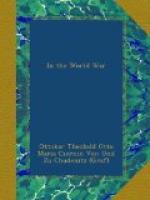“I would further point out that our U-boats, inasmuch as concerns the food situation in England, are operating under quite exceptionally favourable conditions; the world’s record harvest of 1915 has been followed by the world’s worst harvest of 1916, representing a loss of 45-50 million tons of bread and fodder-grain. The countries hardest hit are those most favourably situated, from the English point of view, in North America. The effects are now—the rich stocks from the former harvest having been consumed—becoming more evident every day and everywhere. The Argentine has put an embargo on exports of grain. As to the condition of affairs in the United States, this may be seen from the following figures:
“The Department of Agriculture estimates the stocks of wheat still in the hands of the farmer on March 1, 1917, at 101 million bushels, or little over 21/2 million tons. The stocks for the previous year on that date amounted to 241 million bushels. Never during the whole of the time I have followed these figures back have the stocks been so low or even nearly so. The same applies to stocks of maize. Against a supply of 1,138,000 bushels on March 1, 1916, we have for this year only 789,000 bushels.
“The extraordinary scarcity of supplies is nearing the panic limit. The movement of prices during the last few weeks is simply fantastic. Maize, which was noted in Chicago at the beginning of January, 1917, at 95 cents, rose by the end of April to 127 cents, and by April 25 had risen further to 148 cents. Wheat in New York, which stood at 871/4 cents in July, 1914, and by the beginning of 1917 had already risen to 1911/2 cents, rose at the beginning of April to 229 cents, and was noted at no less than 281 on April 2. This is three and a half times the peace figure! In German currency at normal peace time exchange, these 281 cents represent about 440 marks per ton, or, at present rate of exchange for dollars, about 580 marks per ton.
“That, then, is the state of affairs in the country which is to help England in the war of starvation criminally begun by itself!
“In England no figures are now made public as to imports and stocks of grain. I can, however, state as follows:
“On the last date for which stocks were noted, January 13, 1917, England’s visible stocks of wheat amounted to 5.3 million quarters, as against 6.3 and 5.9 million quarters in the two previous years. From January to May and June there is, as a rule, a marked decline in the stocks, and even in normal years the imports during these months do not cover the consumption. In June, 1914 and 1915, the visible stocks amounted only to about 2 million quarters, representing the requirements for scarcely three weeks.
“We have no reason to believe that matters have developed more favourably during the present year. This is borne out by the import figures for January—as published. The imports of bread-corn and fodder-grain—I take them altogether, as in the English regulations for eking out supplies—amounted only to 12.6 million quarters, as against 19.8 and 19.2 in the two previous years.




